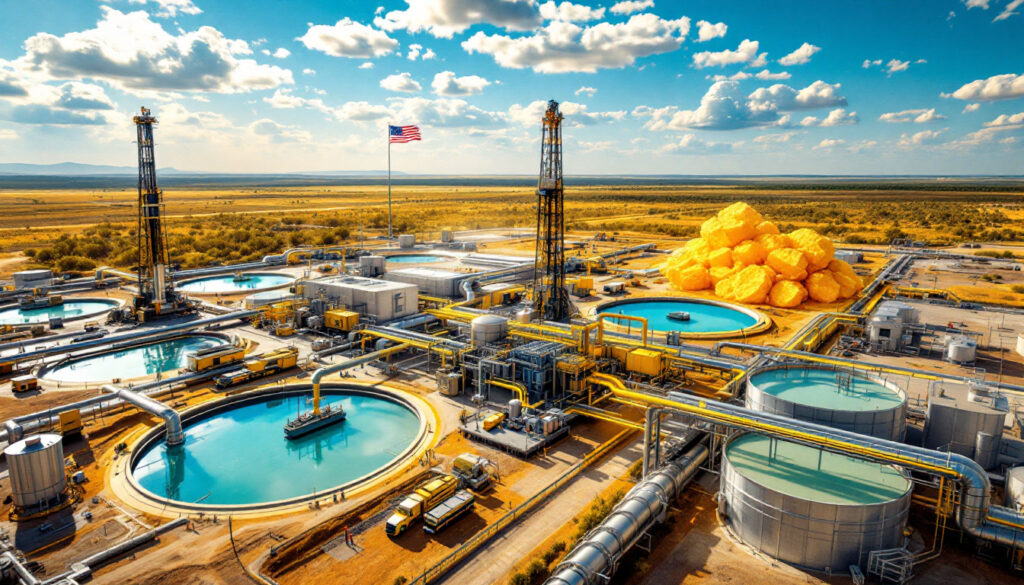Alta Mesa Uranium Project: Boss Energy's Strategic Investment
Boss Energy's Stake in Alta Mesa
In a strategic move to diversify its uranium portfolio, Boss Energy acquired a 30% ownership stake in the Alta Mesa Uranium Project from enCore Energy in February 2024. This acquisition represents a significant expansion beyond the company's flagship Honeymoon project in South Australia, positioning Boss as a multi-jurisdictional uranium producer with immediate production capabilities.
The investment provides Boss Energy with unencumbered rights to 30% of uranium production from Alta Mesa, equivalent to approximately 450,000 pounds annually at full capacity. This stake complements the company's existing operations at Honeymoon, which continues to progress through its development phase.
The timing of this acquisition coincides with growing demand for uranium globally, particularly in the United States where nuclear energy remains a critical component of clean energy strategies. Industry analysts note that Boss Energy's market capitalization saw a notable increase following the announcement, reflecting positive investor sentiment toward the company's expansion strategy.
"This strategic stake in Alta Mesa accelerates our timeline to revenue generation while diversifying our production base across stable mining jurisdictions," commented Duncan Craib, Boss Energy's CEO. "The structure of this agreement allows us to benefit from enCore's operational expertise while maintaining our focus on bringing Honeymoon to full production."
What is the Alta Mesa Uranium Project?
The Alta Mesa Uranium Project is an in situ recovery (ISR) uranium operation located in the prolific uranium belt of South Texas. ISR technology represents one of the most environmentally friendly and cost-effective methods of uranium extraction, using a series of injection and production wells that circulate a mining solution through uranium-bearing sandstone formations.
At the heart of the operation is the Alta Mesa Central Processing Plant (CPP), a sophisticated facility designed to process uranium-rich solutions extracted from multiple wellfields. The plant returned to operations in June 2024 after several years of care and maintenance, marking a significant milestone for both enCore Energy and Boss Energy.
The project is targeting an annualized production rate of 1.5 million pounds of uranium, making it one of the more substantial uranium operations in the United States. ISR technology is particularly well-suited to the geological conditions at Alta Mesa, where uranium deposits are found in permeable sandstone aquifers.
Dr. Sarah Lin, a leading ISR geochemist, explains: "The Alta Mesa deposit's geology is ideal for in situ recovery, with good permeability and confined aquifer conditions that allow for efficient uranium extraction while minimizing environmental impact. The sandstone-hosted uranium can be selectively dissolved and pumped to the surface without traditional mining disturbance."
The Alta Mesa property encompasses approximately 200,000 acres of mineral rights, providing significant exploration upside beyond the current production areas. This extensive land package represents one of the larger uranium exploration portfolios in the United States.
Recent Production Achievements
The Alta Mesa project has demonstrated impressive production momentum in recent months, capturing approximately 50,000 pounds of uranium between March 6-31, 2025. This production achievement is particularly noteworthy as it represents only 26 operational days, translating to a record daily capture rate exceeding 1,900 pounds per day.
This production rate marks the highest level since operations resumed in 2024, confirming the successful recommissioning of the facility and validating the investment thesis for both enCore and Boss Energy. Industry observers note that achieving such production levels so quickly after restart demonstrates the quality of both the resource and operational management.
"March's throughput exceeded our feasibility study projections by over 20%," noted enCore's Chief Operating Officer. "The production team has optimized the wellfield flow patterns and processing circuits faster than anticipated, allowing us to capitalize on favorable uranium market dynamics."
Year-to-date, the project has delivered approximately 290,000 pounds of uranium to utility companies, representing a substantial portion of its contracted obligations for 2025. This production places Alta Mesa among the top-producing uranium facilities in the United States, where domestic production has been limited in recent years due to depressed uranium prices.
The rapid ramp-up in production capability demonstrates the technical advantages of brownfield ISR projects, which can respond to market conditions more quickly than conventional underground or open-pit uranium mines that typically require years of development before reaching production.
Technical Expansion and Infrastructure
March 2025 marked a significant technical milestone for Alta Mesa with the addition of a second ion exchange (IX) circuit to the processing plant. This upgrade effectively doubled the facility's flow capacity from 2,500 to 5,000 gallons per minute (GPM), substantially enhancing uranium capture capabilities.
Ion exchange technology is fundamental to ISR uranium production, using specialized resins to selectively capture uranium ions from the pregnant solution pumped from wellfields. The expansion of this circuit represents a relatively low-capital means of increasing production without the need for additional wellfield development.
The facility experienced a brief one-day disruption in March due to power failures resulting from torrential rainfall in the region. This weather event caused instability in the local electrical grid, highlighting the importance of backup power systems at remote processing facilities.
"Following the weather-related disruption, we've implemented enhanced power redundancy systems to ensure operational continuity during future weather events," explained Alta Mesa's facility manager. "These upgrades include backup generators and improved surge protection that will maintain critical systems during grid fluctuations."
The doubled flow capacity represents a significant operational advantage, as it allows for processing more uranium-bearing solution without proportional increases in operating costs. This efficiency gain directly impacts the project's production economics, particularly as uranium prices have strengthened throughout 2024-2025.
Drilling Operations and Development
The Alta Mesa project currently features an impressive 21 drill rigs operating across various parts of the property, demonstrating the scale of development activities underway. This represents one of the largest active uranium drilling campaigns in the United States, reflecting both companies' confidence in the project's potential.
Of these rigs, 14 are focused on installing and advancing Wellfield 7 (PAA-7), which represents the next major production area for the operation. These activities include installing injection and production wells, monitoring wells, and associated infrastructure required for ISR operations.
An additional four rigs are conducting development drilling at Wellfield 8 (PAA-8), laying the groundwork for future production expansion. This sequential wellfield development approach ensures continuous production as individual wellfields are depleted over time.
Exploration activities remain a priority, with two rigs dedicated to exploration drilling at Alta Mesa and one rig operating at the Upper Spring Creek area. These exploration efforts aim to expand the resource base and extend the project's operational life.
"The extensive drilling campaign at Alta Mesa allows us to advance multiple objectives simultaneously," noted the project's chief geologist. "We're not only preparing new wellfields for near-term production but also identifying extensions of known mineralization that will sustain operations well into the future."
The wellfield development strategy employs a phased approach that optimizes capital deployment while maintaining production continuity. Wellfield 7 is expected to reach full productivity in Q3 2025, with Wellfield 8 following approximately six months later, providing a steady pipeline of new production areas.
Contract Fulfillment and Market Position
Alta Mesa has demonstrated strong performance in meeting and exceeding its contract obligations to utility customers. In a notable development, the project has advanced certain deliveries originally scheduled for August 2025 to May 2025, highlighting both production capability and strategic flexibility in managing market opportunities.
This early fulfillment capability positions the operation favorably in the uranium market, where reliability of supply has become increasingly valued by utility customers facing potential shortfalls from traditional suppliers. The project remains on track to deliver an additional 365,000 pounds through the remainder of 2025, fulfilling its contractual commitments.
"Our ability to accelerate deliveries demonstrates operational reliability and allows us to optimize our sales strategy in response to market conditions," explained Boss Energy's commercial director. "This flexibility is particularly valuable in the current uranium market, which has seen increased price volatility."
The strategic positioning of Alta Mesa within the U.S. domestic uranium market provides additional advantages. As utilities seek to diversify their supply chains and reduce dependence on imports, domestic producers like Alta Mesa benefit from proximity to customers and reduced geopolitical risks compared to overseas suppliers.
Industry analysts have noted that Alta Mesa's production economics appear favorable at current uranium prices, with all-in sustaining costs estimated to be significantly below current spot and term contract prices. This margin provides robust economic returns for both enCore as operator and Boss Energy as 30% stakeholder.
How Does Alta Mesa Complement Boss Energy's Portfolio?
The Alta Mesa investment represents a strategic diversification beyond Boss Energy's Australian operations, creating a multi-jurisdictional production profile that reduces geographic risk. This approach mirrors strategies employed by larger uranium producers who maintain operations across multiple regulatory environments.
Perhaps most significantly, Alta Mesa provides Boss Energy with immediate production and revenue while the company continues developing its Honeymoon project in South Australia. This dual-track approach accelerates Boss Energy's transformation from developer to producer, enhancing its market credibility and cash flow profile.
"The Alta Mesa stake creates a complementary asset portfolio spanning two of the world's most stable mining jurisdictions," noted a resource sector analyst following the company. "This diversification helps mitigate permitting, regulatory, and operational risks while providing exposure to both the U.S. and global uranium markets."
From a technical perspective, the ISR operations at Alta Mesa share technological similarities with Honeymoon, allowing for knowledge transfer and operational synergies despite geographic separation. Both projects utilize ISR technology, though with adaptations specific to their respective geological and regulatory environments.
The investment structure also proves advantageous, as Boss Energy gains immediate production exposure without assuming operational responsibilities. This arrangement allows the company to benefit from enCore's established operational expertise in Texas while maintaining management focus on bringing Honeymoon to full production.
Future Production Outlook
Alta Mesa's future production trajectory appears promising, with continued ramp-up toward its 1.5 million pound annual target expected through 2025. The systematic development of new wellfields provides a clear pathway to achieving and potentially exceeding this production level in coming years.
Exploration activities currently underway hold significant potential for resource expansion beyond currently defined production areas. The extensive land package controlled by the project includes numerous prospective targets identified through historical exploration that remain underdeveloped.
"The sequential development of wellfields, coupled with ongoing exploration success, creates a production profile that could extend well beyond initial projections," commented enCore's exploration director. "We see potential to not only sustain but potentially grow production rates as new areas are brought online."
The project's infrastructure, particularly the recent expansion of processing capacity, provides a foundation for increased production without proportional capital investment. The central processing plant's design allows for modular expansion as additional wellfields are developed, optimizing capital efficiency.
Regulatory factors also favor expansion, as the project operates within an established framework for ISR uranium production in Texas. The Texas Commission on Environmental Quality (TCEQ) has extensive experience with ISR operations, providing regulatory predictability that supports long-term planning.
Market conditions will ultimately influence production decisions, with the ability to accelerate or moderate production rates in response to uranium pricing. The favorable economics at current price levels provide strong incentives for continued expansion, particularly as global uranium demand continues to strengthen amid nuclear power growth.
FAQ About Boss Energy's Alta Mesa Investment
What percentage of Alta Mesa does Boss Energy own?
Boss Energy acquired a 30% stake in the Alta Mesa uranium project from enCore Energy in February 2024, with enCore remaining as the operator with 70% ownership. This structure provides Boss with rights to 30% of all uranium production without operational responsibilities.
How much uranium is Alta Mesa currently producing?
The project captured 50,000 pounds of uranium between March 6-31, 2025, achieving a record daily capture rate exceeding 1,900 pounds per day. At this production rate, the operation is on track to deliver approximately 655,000 pounds in 2025.
What is the annual production target for Alta Mesa?
Alta Mesa is progressing toward a targeted annualized production rate of 1.5 million pounds of uranium. This target represents full production capacity based on current infrastructure, though expansion potential exists through additional wellfield development.
How does Alta Mesa compare to Boss Energy's Honeymoon project?
While Honeymoon in South Australia represents Boss Energy's flagship project with potential production of 2.45 million pounds annually at full capacity, Alta Mesa provides immediate production and revenue diversification. Both utilize ISR technology but operate under different regulatory frameworks.
What advantages does the Alta Mesa investment provide to Boss Energy?
The investment accelerates Boss Energy's transition to producer status, provides geographic diversification, creates immediate revenue streams, and establishes a presence in the U.S. uranium market. The structure also allows Boss to benefit from production without taking on operational responsibilities.
What expansion potential exists at Alta Mesa?
The project controls approximately 200,000 acres with significant exploration potential. Current exploration activities at Alta Mesa and Upper Spring Creek aim to identify additional resources that could extend the project's life and potentially increase production capacity beyond current targets. For investors interested in the broader context, understanding uranium investment opportunities and mining investment strategies can provide valuable perspectives when evaluating the Boss Energy and Alta Mesa uranium production developments. Furthermore, mining feasibility insights can be crucial for those investing in mining stocks in this sector.
Looking for Early Alerts on the Next Alta Mesa-Scale Uranium Discovery?
Stay ahead of the market with Discovery Alert's proprietary Discovery IQ model, which instantly identifies significant ASX mineral discoveries across uranium and 30+ other commodities. Visit the Discovery Alert discoveries page to understand how early notification of major mineral finds can transform your investment portfolio.




